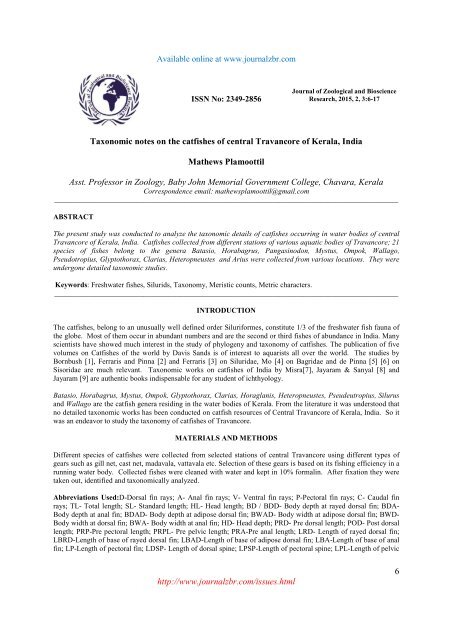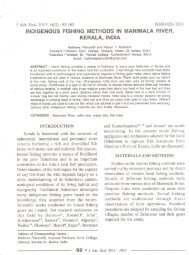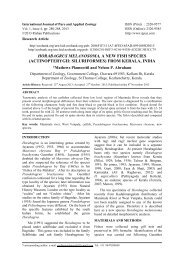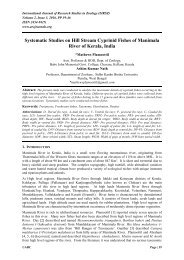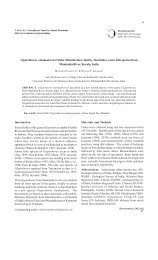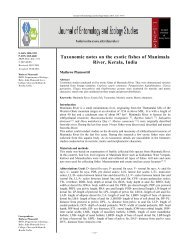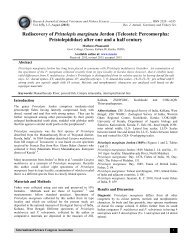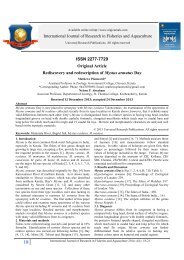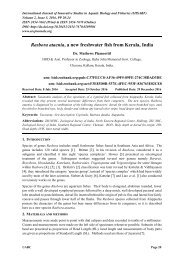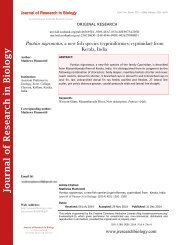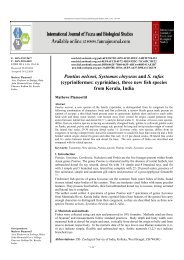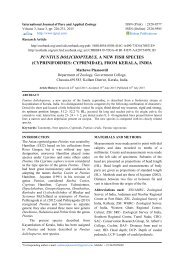Taxonomic Notes on Catfishes of Travancore...JZBR - Copy
Create successful ePaper yourself
Turn your PDF publications into a flip-book with our unique Google optimized e-Paper software.
Available <strong>on</strong>line at www.journalzbr.com<br />
ISSN No: 2349-2856<br />
Journal <strong>of</strong> Zoological and Bioscience<br />
Research, 2015, 2, 3:6-17<br />
<str<strong>on</strong>g>Tax<strong>on</strong>omic</str<strong>on</strong>g> notes <strong>on</strong> the catfishes <strong>of</strong> central <strong>Travancore</strong> <strong>of</strong> Kerala, India<br />
Mathews Plamoottil<br />
Asst. Pr<strong>of</strong>essor in Zoology, Baby John Memorial Government College, Chavara, Kerala<br />
Corresp<strong>on</strong>dence email: mathewsplamoottil@gmail.com<br />
_____________________________________________________________________________________________<br />
ABSTRACT<br />
The present study was c<strong>on</strong>ducted to analyze the tax<strong>on</strong>omic details <strong>of</strong> catfishes occurring in water bodies <strong>of</strong> central<br />
<strong>Travancore</strong> <strong>of</strong> Kerala, India. <strong>Catfishes</strong> collected from different stati<strong>on</strong>s <strong>of</strong> various aquatic bodies <strong>of</strong> <strong>Travancore</strong>; 21<br />
species <strong>of</strong> fishes bel<strong>on</strong>g to the genera Batasio, Horabagrus, Pangasinod<strong>on</strong>, Mystus, Ompok, Wallago,<br />
Pseudotropius, Glyptothorax, Clarias, Heteropneustes and Arius were collected from various locati<strong>on</strong>s. They were<br />
underg<strong>on</strong>e detailed tax<strong>on</strong>omic studies.<br />
Keywords: Freshwater fishes, Silurids, Tax<strong>on</strong>omy, Meristic counts, Metric characters.<br />
_____________________________________________________________________________________________<br />
INTRODUCTION<br />
The catfishes, bel<strong>on</strong>g to an unusually well defined order Siluriformes, c<strong>on</strong>stitute 1/3 <strong>of</strong> the freshwater fish fauna <strong>of</strong><br />
the globe. Most <strong>of</strong> them occur in abundant numbers and are the sec<strong>on</strong>d or third fishes <strong>of</strong> abundance in India. Many<br />
scientists have showed much interest in the study <strong>of</strong> phylogeny and tax<strong>on</strong>omy <strong>of</strong> catfishes. The publicati<strong>on</strong> <strong>of</strong> five<br />
volumes <strong>on</strong> <strong>Catfishes</strong> <strong>of</strong> the world by Davis Sands is <strong>of</strong> interest to aquarists all over the world. The studies by<br />
Bornbush [1], Ferraris and Pinna [2] and Ferraris [3] <strong>on</strong> Siluridae, Mo [4] <strong>on</strong> Bagridae and de Pinna [5] [6] <strong>on</strong><br />
Sisoridae are much relevant. <str<strong>on</strong>g>Tax<strong>on</strong>omic</str<strong>on</strong>g> works <strong>on</strong> catfishes <strong>of</strong> India by Misra[7], Jayaram & Sanyal [8] and<br />
Jayaram [9] are authentic books indispensable for any student <strong>of</strong> ichthyology.<br />
Batasio, Horabagrus, Mystus, Ompok, Glyptothorax, Clarias, Horaglanis, Heteropneustes, Pseudeutropius, Silurus<br />
and Wallago are the catfish genera residing in the water bodies <strong>of</strong> Kerala. From the literature it was understood that<br />
no detailed tax<strong>on</strong>omic works has been c<strong>on</strong>ducted <strong>on</strong> catfish resources <strong>of</strong> Central <strong>Travancore</strong> <strong>of</strong> Kerala, India. So it<br />
was an endeavor to study the tax<strong>on</strong>omy <strong>of</strong> catfishes <strong>of</strong> <strong>Travancore</strong>.<br />
MATERIALS AND METHODS<br />
Different species <strong>of</strong> catfishes were collected from selected stati<strong>on</strong>s <strong>of</strong> central <strong>Travancore</strong> using different types <strong>of</strong><br />
gears such as gill net, cast net, madavala, vattavala etc. Selecti<strong>on</strong> <strong>of</strong> these gears is based <strong>on</strong> its fishing efficiency in a<br />
running water body. Collected fishes were cleaned with water and kept in 10% formalin. After fixati<strong>on</strong> they were<br />
taken out, identified and tax<strong>on</strong>omically analyzed.<br />
Abbreviati<strong>on</strong>s Used:D-Dorsal fin rays; A- Anal fin rays; V- Ventral fin rays; P-Pectoral fin rays; C- Caudal fin<br />
rays; TL- Total length; SL- Standard length; HL- Head length; BD / BDD- Body depth at rayed dorsal fin; BDA-<br />
Body depth at anal fin; BDAD- Body depth at adipose dorsal fin; BWAD- Body width at adipose dorsal fin; BWD-<br />
Body width at dorsal fin; BWA- Body width at anal fin; HD- Head depth; PRD- Pre dorsal length; POD- Post dorsal<br />
length; PRP-Pre pectoral length; PRPL- Pre pelvic length; PRA-Pre anal length; LRD- Length <strong>of</strong> rayed dorsal fin;<br />
LBRD-Length <strong>of</strong> base <strong>of</strong> rayed dorsal fin; LBAD-Length <strong>of</strong> base <strong>of</strong> adipose dorsal fin; LBA-Length <strong>of</strong> base <strong>of</strong> anal<br />
fin; LP-Length <strong>of</strong> pectoral fin; LDSP- Length <strong>of</strong> dorsal spine; LPSP-Length <strong>of</strong> pectoral spine; LPL-Length <strong>of</strong> pelvic<br />
http://www.journalzbr.com/issues.html<br />
6
Mathews Plamoottil J. Zool. Biosci. Res., 2015, 2 (3):6-17<br />
______________________________________________________________________________<br />
fin; LCP-Length <strong>of</strong> caudal peduncle; DCP-Depth <strong>of</strong> caudal peduncle; WCP- Width <strong>of</strong> caudal fin; LA-Length <strong>of</strong> anal<br />
fin; LAD-Length (height) <strong>of</strong> adipose dorsal fin; LBPL- Length <strong>of</strong> base <strong>of</strong> pelvic fin; LBP-Length <strong>of</strong> base <strong>of</strong> pectoral<br />
fin; DAV- Distance from anal to vent; DVV- Distance from ventral to vent; DRD & AD- Distance from rayed dorsal<br />
to adipose dorsal fin; DP-PL- Distance from pectoral to pelvic; DPL-A- Distance from pelvic to anal; DA- C-<br />
Distance from anal to caudal; LATA- length <strong>of</strong> adhesive thoracic apparatus; WATA- Width <strong>of</strong> adhesive thoracic<br />
apparatus; LUCL- Length <strong>of</strong> upper caudal lobe; LLCL- Length <strong>of</strong> lower caudal lobe; ; DO- ST-Distance from<br />
occiput to snout; DO-D- Distance from occiput to dorsal fin; HW- Head width; ED- Eye diameter; IOW-Inter orbital<br />
width; INW- Inter narial width; STL-Snout length; WGM- Width <strong>of</strong> gape <strong>of</strong> mouth; LMB-Length <strong>of</strong> maxillary<br />
barbels; LNB-length <strong>of</strong> nasal barbels; LOMB-Length <strong>of</strong> outer mandibular barbels; LIMB-Length <strong>of</strong> inner<br />
mandibular barbels.<br />
RESULTS AND DISCUSSION<br />
Twenty <strong>on</strong>e species <strong>of</strong> catfishes were collected from various selected sites <strong>of</strong> <strong>Travancore</strong> during 2010- 2012 (Table<br />
1 & Fig. 1 – 20). Of different species <strong>of</strong> fishes collected, species <strong>of</strong> genus Mystus outnumbered all others. Seven<br />
new catfishes were discovered, named and described during this study; they bel<strong>on</strong>g to the genera Batasio,<br />
Horabagrus, Mystus and Glyptothorax. Culturable fishes are Pangasinod<strong>on</strong> hypothalamus, Clarius gariepinus,<br />
Wallago attu and Heteropneustes fossilis. The first two are exotic. Arius subrostratus is an estuarine fish might<br />
have been ascended from Vembanad Lake. All the fishes except Batasio travancoria, B. flavus and Glyptothorax<br />
elankadensis are edible.<br />
Batasiotravancoria Hora and Law<br />
Fig. 1.Batasio travancoria<br />
Fig. 2.Batasio flavus<br />
Batasio travancoria Hora & Law, 1941, Rec. Indian Mus. 43 (1): 40 (type locality: Perumthenaruvi, tributary <strong>of</strong><br />
Pamba River at Edakadathy, Kerala).<br />
Diagnosis: Body with a narrow dark streak al<strong>on</strong>g lateral line; a triangular spot present at the caudal peduncle. Many<br />
pores and skin folding present <strong>on</strong> the head regi<strong>on</strong>. Barbels not extending bey<strong>on</strong>d eyes; a distinct depressi<strong>on</strong>, shaded<br />
by a bluish black color present <strong>on</strong> humeral regi<strong>on</strong>; a black line present in between humeral and caudal blotches.<br />
Meristic counts: D- I, 7; A- 12; V-I, 5; P-I, 7; C-16.<br />
Metric Characters: TL (mm)- 86.0; SL (mm)- 70.0; HL (mm)- 16.0.% SL: BD- 20.0; HL- 22.9; HD-17.1; PRD-<br />
38.6; POD- 65.7; PRP-50.0; PRA-74.3; LD-14.3; LBRD-12.8; LBAD- 28.6; LBA-15.7; LP-12.8; LPL-14.3; LCP-<br />
15.7; DCP-12.1; LA-8.6; LAD-1.4; LBPL- 4.3; LBP- 4.3. % HL: HD- 75.0; ED- 15.6; IOW- 37.5; STL- 43.8;<br />
LMB- 43.8; LNB- 25.0; LOMB-18.8; LIMB-9.4.<br />
Other features: Live fishes have a dark pink color; ventral side yellowish white; ventro lateral side <strong>of</strong> the body has<br />
minute distinct black spots; all fins, except ventral, have a moderate dark shade. Pectoral spine deeply serrated<br />
behind; its outer side granulated or <strong>on</strong>ly very finely serrated; caudal lobes have unequal length. Adipose dorsal<br />
present <strong>on</strong> a thin l<strong>on</strong>g ridge; its length <strong>of</strong> base greatly l<strong>on</strong>ger compared to all other fins.<br />
http://www.journalzbr.com/issues.html<br />
7
Mathews Plamoottil J. Zool. Biosci. Res., 2015, 2 (3):6-17<br />
______________________________________________________________________________<br />
Table 1.Syn<strong>on</strong>yms. systematic positi<strong>on</strong> and comm<strong>on</strong> names <strong>of</strong> the catfishes <strong>of</strong> Central <strong>Travancore</strong><br />
Sl.<br />
No.<br />
Name <strong>of</strong> Species Syn<strong>on</strong>yms Order Family Comm<strong>on</strong><br />
Name<br />
1 Batasio travancoria Nil Siluriformes Bagridae,<br />
Bagrinae<br />
<strong>Travancore</strong><br />
Batasio<br />
2 Batasio flavus Nil Siluriformes Bagridae,<br />
Yelow Batasio<br />
Bagrinae<br />
3 Horabagrus<br />
brachysoma<br />
Siluriformes<br />
Bagridae,<br />
Bagrinae<br />
Gunther’s<br />
catfish<br />
Pseudobagrus brachysoma<br />
Pseudobagrus chryseus<br />
Macr<strong>on</strong>es chryseus<br />
4 Horabagrus<br />
melanosoma<br />
Siluriformes<br />
Bagridae,<br />
Bagrinae<br />
5 Pangasinod<strong>on</strong><br />
Nil Siluriformes Pangasidae<br />
hypothalamus<br />
6 Mystus oculatus Bagrus oculatus<br />
Siluriformes<br />
Bagridae,<br />
Macr<strong>on</strong>es oculatus<br />
Bagrinae<br />
7 Mystus gulio Pimelodus gulio<br />
Siluriformes<br />
Bagridae,<br />
Macr<strong>on</strong>es gulio<br />
Bagrinae<br />
8 Mystus keralai Nil Siluriformes Bagridae,<br />
Bagrinae<br />
9 Mystus heoki Nil Siluriformes Bagridae,<br />
Bagrinae<br />
10 Mystus men<strong>on</strong>i Nil Siluriformes Bagridae,<br />
Bagrinae<br />
11 Mystus indicus Nil Siluriformes Bagridae,<br />
Bagrinae<br />
Black<br />
Horabagrus<br />
Malabar Mystus<br />
L<strong>on</strong>gwhiskered<br />
catfish,<br />
Shadow cat fish<br />
L<strong>on</strong>gwhiskered<br />
Kerala catfish<br />
El<strong>on</strong>gated<br />
Kerala Mystus<br />
Idukki Mystus<br />
Central<br />
<strong>Travancore</strong><br />
catfish<br />
Nil<br />
12 Mystus canarensis Hara malabarica Siluriformes Bagridae,<br />
Bagrinae<br />
13 Ompok malabaricus Silurus malabaricus<br />
Siluriformes Siluridae Goan catfish<br />
Callichrous malabaricus<br />
Silurus goae<br />
14 Ompok bimaculatus Silurus bimaculatus<br />
Siluriformes Siluridae Indian butter<br />
Callichrous bimaculatus<br />
catfish<br />
Callichrousmacrophthalmus<br />
Ompokcanio<br />
Ompoksindensis<br />
15 Wallago attu Silurus attu<br />
Wallag<strong>on</strong>ia attu<br />
W. attu valeya<br />
16 Pseudotropius<br />
mitchelli<br />
17 Glyptothorax<br />
elankadensis<br />
Siluriformes Siluridae Boal,<br />
Freshwater<br />
shark,<br />
Shark catfish<br />
Malabar Patashi<br />
Pseudotropius sykesii Siluriformes Schilbeidae<br />
Schilbeinae<br />
Nil Siluriformes Sisoridae <strong>Travancore</strong> rock<br />
catfish<br />
18 Clarius dussumeiri Nil Siluriformes Clariidae Valenciennes’<br />
clariid<br />
19 Clarius garipinus Nil Siluriformes Clariidae Burchell’s<br />
clariid<br />
20 Arius subrostratus Pimelodus arius<br />
Siluriformes Aridae Treadfin catfish<br />
Arius buchanani<br />
Tachysurus arius<br />
21 Heteropneustes fossilis Silurus fossilis<br />
Sacchobranchus fossilis<br />
Siluriformes Heteropneustidae Stinging catfish<br />
Batasio flavus Plamoottil<br />
Batasi<strong>of</strong>lavus,Plamoottil, 2015, Journal <strong>of</strong> Research in Biology, 5 (5): 1799- 1808 (Type locality: Paduthode,<br />
Manimala River, Kerala, India)<br />
Diagnosis: It can be distinguished from its c<strong>on</strong>geners in having a slender (BDD 16.0-18.0 % SL) body; flatter (HD<br />
53.0-57.1 % SL) head; occipital process very small and hidden under skin; orbits widely set (IOW 27.0-31.3 % HL);<br />
http://www.journalzbr.com/issues.html<br />
8
Mathews Plamoottil J. Zool. Biosci. Res., 2015, 2 (3):6-17<br />
______________________________________________________________________________<br />
dorsal pr<strong>of</strong>ile nearly straight; single median l<strong>on</strong>gitudinal groove <strong>on</strong> head; adipose dorsal fin with a straight margin<br />
for entire length and inserted behind a c<strong>on</strong>siderable distance from rayed dorsal fin.<br />
Meristic counts: D- I, 7; A- iv, 9- 10; V-5; P-I, 7- 8; C-17.<br />
Metric Characters: TL (mm)- 82.0-106.0; SL (mm)- 69.0-88.0; HL (mm)- 16.0-21.0. % SL: BD- 16.0-18.0; HL-<br />
21.0-23.8; HD- 11.1- 13.6; PRD- 32.6-35.8; POD-63.0-65.2; PRP-21.7-23.9: PRA-65.0-68.0; LRD-13.6-17.6;<br />
LBRD-13.1-14.5; LBAD-25.0-29.0; LBA-14.2-16.0; LP-14.8-17.3; LPL-12.3-14.8; LCP- 17.2-21.7; DCP-8.6-11.6;<br />
LA-11.1-12.5; LAD-3.0- 5.0; LBPL- 3.3-4.1; LBP-3.6-4.3.<br />
Other Features: Body and fins yellow; a small brownish black triangular spot present in fr<strong>on</strong>t <strong>of</strong> rayed dorsal fin<br />
base; a triangular dark or light brownish black spot present <strong>on</strong> caudal base. A thin brownish black line passes<br />
through mid lateral line.<br />
Horabagrus brachysoma (Gunther)<br />
Pseudobagrus brachysoma Gunther, 1864, Cat. Fish. Brit. Mus. 5: 86 (type locality: “Cochin China” lapsuscalami<br />
for Cochin).<br />
Diagnosis: occipital process extends to pre dorsal plate; mouth sub terminal; a large round blotch present at the<br />
branchial regi<strong>on</strong>. Maxillary barbels extend to pectoral fin base; rayed dorsal fin with a str<strong>on</strong>g, feebly serrated spine;<br />
adipose dorsal fin is short and low.<br />
Fig. 3.Horbagrus brachysoma;<br />
Fig. 4.Horbagrus melanosoma<br />
Meristic charaters: D- I, 6-7; P- I, 8-9; V- I, 5; A- III, 20- 25. C- 17.<br />
Metric characters: TL (mm) - 214.0; SL (mm)- 175.0.% SL: HL- 28.4; HD- 17.4; HW- 20.9; BD- 22.7; PRD- 37.2;<br />
POD- 60.5; PRP- 23.5; PRA- 63.1; PRPL- 52.0; LRD- 20.6; LBRD- 9.5; LBAD- 4.4; LBA- 24.6; LP- 20.0; LPL-<br />
11.5; DCP- 12.0; LCP- 12.5; LA- 12.6; LAD- 7.4; LBPL- 4.1; LBP- 4.9. % HL: HD- 61.4; HW- 73.6; ED- 18.7;<br />
IOW- 53.9; INW- 32.6; STL- 40.2; WGM- 48.8; LMB- 70.5; LNB- 59.3; LOMB- 65.2; LIMB- 47.6.<br />
Other features: Color dark greenish above with golden yellow flanks; dorsal and anal fins yellowish orange; caudal<br />
fin yellow; a semi lunar thick black patch present at the caudal fin base.<br />
Horabagrus melanosoma Plamoottil & Abraham<br />
Horabagrus melanosoma, Plamoottil& Abraham, 2013, Int.J. Pure Appl. Zool, 1 (4): 280-288 (Type locality: West<br />
Venpala).<br />
Diagnosis: Color black to grayish black, fins grey to black, pelvic fin does not reach anal fin and the latter with iii,<br />
28- 30 rays. Lengths <strong>of</strong> head, dorsal fin, dorsal spine and pectoral spine shorter compared to the c<strong>on</strong>geners.<br />
Meristic counts: D- II, 6; P- I, 7-8; V- i, 5; A- iii, 28- 30; C- 17.<br />
http://www.journalzbr.com/issues.html<br />
9
Mathews Plamoottil J. Zool. Biosci. Res., 2015, 2 (3):6-17<br />
______________________________________________________________________________<br />
Metric characters: TL ( mm)- 124.0-282.0; SL (mm)- 96.0-235.0. % SL: HL-21.9- 27.6; BDD-18.8- 24.0; PRD-<br />
32.7-37.0; POD-60.7- 71.4; PRP- 21.9- 24.1; PRA- 60.2-64.7; PRPL- 45.2- 51.1; LRD- 16.2-19.5; LBRD- 7.7- 8.4;<br />
LBAD- 3.8- 4.5; LBA- 23.1- 25.6; LP- 15.7- 20.1; DCP- 9.8- 10.6; LCP-8.7- 13.0; LA- 8.9- 11.0; LAD- 7.5- 8.0. %<br />
HL: HD- 59.2- 80.0; HW-75.0- 102; ED-16.7-22.2; IOW-53.0- 66.7; STL-35.2- 45.6; WGM-46.3- 57.8; LMB-51.8-<br />
77.8; LNB-46.6- 55.6; LOMB-62.1- 77.8; LIMB- 41.4- 53.4.<br />
Remarks<br />
It is the third species <strong>of</strong> Horabagrus discovered from Kerala; it is an edible fish endemic to Kerala.<br />
Pangasinod<strong>on</strong> hypothalamus (Sauvage)<br />
Helicophagus hypophthalmus, Sauvage, H.-E. 1878. Bulletin de la Sociétéphilomathique de Paris (7th Séries) v. 2:<br />
233-242.<br />
Diagnosis: Head dorso- ventrally flattened; rest <strong>of</strong> the body laterally compressed; pelvic fins with 8 rays; maxillaries<br />
and mandibulars short; maxillaries never reach base <strong>of</strong> pectoral or outermost part <strong>of</strong> opercle.<br />
Fig. 5. Pangsinod<strong>on</strong> hypothalamus<br />
Fig. 6. Mystus oculatus<br />
Meristic counts: D- I, 7; P- I, i, 9; V- i, 7; A - iv, 29; C- 18.<br />
Metric characters: SL (mm)- 375.0; HL (mm) – 100.% SL:HL- 26.7; BDD- 40.0; BDA-34.7; BWD-18.7; BWA-<br />
13.3; PRD-37.9; POD-61.3; PRP- 22.9; PRPL-49.3; PRA-61.3; LAD- 5.6; LPL-12.3; LA-12.0; LBRD-7.2; LBA-<br />
29.1; LBP- 5.1; LBPL-5.9; LCP- 13.3; DCP-13.1; WCP- 6.1; DAV-1.1; DVV-9.8.% HL: HD- 65.0; HW- 58.0;<br />
ED- 10.0; IOW- 55.0; STL- 35.0; LMB- 32.0; LOMB- 19.0.<br />
Mystus oculatus (Valenciennes)<br />
Bagrus oculatus Valenciennes, 1839, IN Cuvier &Valenciennes Hist. Nat. Poiss. 14: 434 (type locality: ‘Cote<br />
de’(Kuttiadi), Malabar).<br />
Diagnosis: Occipital process extends to basal b<strong>on</strong>e <strong>of</strong> dorsal fin; median l<strong>on</strong>gitudinal groove <strong>on</strong> head extends to base<br />
<strong>of</strong> occipital process; maxillary barbels extend to middle <strong>of</strong> anal fin; a dark spot is present at the origin <strong>of</strong> the dorsal<br />
fin.<br />
Meristic counts: D- I, 7; A- iii- iv, 8-9; P- I, 6; V- i, 5.<br />
Metric characters: TL (mm)- 10.2; SL (mm)- 7.8; HL (mm)- 18.0.% SL: BDD- 23.1; HL-23.1; HD-21.8; PRD-38.5;<br />
POD-64.1; PRP-50.0; PRA- 69.2; LD-24.4; LBRD-16.7; LBAD-14.1; LBA-12.8; LP- 19.2; LPL-15.4; DCP-10.3;<br />
LCP-10.3; LA-14.1; LAD- 12.8; LBPL- 3.8; LBP- 3.8.<br />
% HL: HD- 94.4; ED-16.7; IOW-41.7; STL-30.6.<br />
Other features: Silvery or yellowish <strong>on</strong> the flanks and darker <strong>on</strong> the dorsal regi<strong>on</strong>; abdomen whitish. Adipose dorsal<br />
fin base short; inter dorsal distance about 1.2 times in adipose dorsal fin base.<br />
http://www.journalzbr.com/issues.html<br />
10
Mathews Plamoottil J. Zool. Biosci. Res., 2015, 2 (3):6-17<br />
______________________________________________________________________________<br />
Mystus gulio (Hamilt<strong>on</strong>- Buchanan)<br />
Pimelodus gulio Hamilt<strong>on</strong>- Buchanan, 1822, Fish <strong>of</strong> Ganges: 201 (type locality: Upper parts <strong>of</strong> Gangetic Provinces).<br />
Diagnosis: Occipital process extends to the basal b<strong>on</strong>e <strong>of</strong> dorsal fin; median l<strong>on</strong>gitudinal groove does not extend to<br />
the occipital process. Maxillary barbels extend to end <strong>of</strong> pelvic fins.<br />
Meristic counts: D- I, 7; P- I, 8-9; V- i, 5; A- iii- iv, 9-11; C - 17.<br />
Fig. 7. Mystus gulio;<br />
Fig. 8. Mystus keralai<br />
Metric characters- TL (mm)- 156.0; SL (mm)- 125.0. % SL: HL- 27.6; HD- 17.8; HW- 21.8; BDD- 21.8; BDA-<br />
18.9; BWD- 19.9; BWA-11.1; PRD-36.8; POD-64.1; PRP-24.7; PRPL-52.2; PRA-67.2; LRD- 21.3; LP- 18.4; LPL-<br />
12.7; LA- 16.0; LBSOD- 11.4; LBA- 11.0; LBP-5.1; LBPL- 4.0; LCP-15.7; DCP-11.1; WCP-5.3. . % HL: ED-<br />
15.55- 18.95; IOW-40- 43.90; INW--21.40- 24.77; STL-35- 39.63; WGM-36.58- 44.44.<br />
Other features: Body dark <strong>on</strong> the flanks and above; dull white below; fins black. Dorsal spine str<strong>on</strong>g, serrated <strong>on</strong> its<br />
inner edge; adipose fin small, inserted c<strong>on</strong>siderably behind rayed dorsal fin; least height <strong>of</strong> caudal peduncle equals<br />
its length.<br />
Mystus keralai Plamoottil & Abraham<br />
Mystus keralai, Plamoottil& Abraham, 2014, Int.J. Pure Appl. Zool., 2 (3): 231- 240 (Type locality: Chenapady,<br />
Manimala River, Kerala).<br />
Diagnosis: Mystus keralai differs from its relative species in having an el<strong>on</strong>gated, wider but less deep head, smaller<br />
eyes, deeper anterior part <strong>of</strong> fr<strong>on</strong>tal groove, l<strong>on</strong>ger adipose dorsal fin and pectoral spine, weaker pectoral spine and<br />
l<strong>on</strong>ger base <strong>of</strong> rayed dorsal fin base.<br />
Meristic counts: D- I, 7; P- I, 8; V-i, 5; A- iv, 9; C- 15.<br />
Metric characters: TL (mm)-72-78; SL (mm)- 58-59. % SL: HL-27.1- 27.6; HD-18.1- 18.9; HW-18.1- 18.9; BDD-<br />
21.0- 22.4; BDA-18.6- 18.9; BWD-15.8- 17.0; BWA-10.3- 11.2; PRD-36.2- 38.9; POD-67.2- 67.8; PRPL-48.3-<br />
54.2; LRD- 22.4- 23.7; LC-29.8- 32.2. % HL: ED-21.9- 25.0; IOW-34.3- 34.4; INW-20.0- 25.0; STL-37.5; WGM-<br />
37.5-45.0.<br />
Mystus heoki Plamoottil& Abraham<br />
Mystus heoki, Plamoottil& Abraham, Biosystematica, 2013: 7(1): 43-58 (Type locality: Elankadu, Idukki Dt, Kerala,<br />
India).<br />
http://www.journalzbr.com/issues.html<br />
11
Mathews Plamoottil J. Zool. Biosci. Res., 2015, 2 (3):6-17<br />
______________________________________________________________________________<br />
Fig. 9.Mystus heoki.<br />
Fig. 10. Mystus men<strong>on</strong>i<br />
Diagnosis: The new species can be differentiated from all its c<strong>on</strong>geners in having a markedly el<strong>on</strong>gated body,<br />
shorter head, smaller eyes, shorter rayed dorsal fin and shorter pectoral fin.<br />
Meristic counts: D- II, 7; P- I, 7; V- i, 5; A- ii- iii, 8; C-15.<br />
Metric characters: TL (mm) - 105.5- 167.0; SL (mm)-85.5- 137.0.% SL: HL-18.9- 22.5; HD-10.9- 12.5; HW-14.8-<br />
17.4; BDD-15.0- 16.9; BDA-13.3- 16.4; BWD- 12.5- 15.2; PRD-31.7- 34.2; POD-59.7- 67.2; PRPL-43.3- 45.9;<br />
LRD-14.3- 15.4; LC-22.7- 24.5.% HL: ED- 16.7- 20.4; IOW-32.4- 38.6; STL- 36.4- 41.7; WGM- 41.7- 48.7.<br />
Mystus men<strong>on</strong>i Plamoottil & Abraham<br />
Mystus men<strong>on</strong>i Plamoottil & Abraham, Int. J. Pure Appl. Zool., 2013, 1(4): 315-325 (type locality: Elankadu,<br />
Manimala River, Kerala, India).<br />
Diagnosis: Mystus men<strong>on</strong>i can be diagnosed from all its c<strong>on</strong>geners in having an el<strong>on</strong>gated snout, widely set eyes,<br />
short inter dorsal distance and a thick bluish green band present in the mid lateral line.<br />
Meristic counts: D- II, 7; P- I, 7; V- I, 5; A- iii, 8; C- 15- 17.<br />
Metric characters: TL (mm)-128.5- 139.0; SL (mm)-101.0- 109.0.% SL: HL-22.9- 24.3; HD-13.9- 15.7; HW-17.8-<br />
18.4; BDD-21.1- 23.6; BDA-16.8-18.8; BWD-17.3- 19.6; PRD- 33.0- 36.9; POD-59.8- 67.9; PRPL-46.3- 51.4;<br />
LRD-16.7- 20.8.% HL: ED-22.9- 25.0; IOW-36.0- 40.4; STL- 34.6- 41.7; WGM-42.3- 50.0<br />
Mystus indicus Plamoottil & Abraham<br />
Mystus indicus, Plamoottil & Abraham, Biosystematica,2013: 7(1): 43-58 (type locality: Kuttoor, Manimala River,<br />
Kerala, India).<br />
Fig. 11.Mystus indicus.<br />
Fig. 12.Mystus canarensis<br />
http://www.journalzbr.com/issues.html<br />
12
Mathews Plamoottil J. Zool. Biosci. Res., 2015, 2 (3):6-17<br />
______________________________________________________________________________<br />
Diagnosis: The new species can be differentiated from its c<strong>on</strong>geners in having an el<strong>on</strong>gated snout, a thick layer <strong>of</strong><br />
flesh present <strong>on</strong> both sides <strong>of</strong> occipital process, pectoral spine with more teeth, greater pre pelvic length, rayed<br />
dorsal fin base prominently swollen <strong>on</strong> both sides and wide caudal peduncle.<br />
Meristic counts: D- I, 7; P- I, 6-8; V-i, 5; A- iii, 7-8; C- 15-17.<br />
Metric characters: TL (mm)-102.5-136.0; SL (mm)- 81.0-107.0.% SL: HL-22.4-26.0; HD-14.4-16.2; HW-16.7-20.2;<br />
BDD-18.8- 25.3; BDA-17.8- 21.2; BWD-16.7-19.2; PRD-30.8-36.0; POD-64.5-70.8; PRPL-50.6-55.5; LRD-15.8-<br />
21.8.% HL: ED-24.0- 29.2; IOW-36.3- 45.0; STL-36.2- 42.5; WGM-34.8- 40.9.<br />
Mystus canarensis (Grant)<br />
Mystus canarensis Grant, S. 1999, Aqua. J. Ichthyol.& Aquatic Biol, 3 (4): 169- 174.<br />
Diagnosis: A prominent dark brown spot present <strong>on</strong> the humeral regi<strong>on</strong>; length <strong>of</strong> base <strong>of</strong> adipose dorsal fin fairly<br />
short; caudal fin lobes overlap each other; pectoral fin with 9 branched rays and caudal fin with 18 rays.<br />
Meristic counts: D- I, 7; P- I, 9; V-i, 5; A- iii, 8; C-18.<br />
Metric characters: TL (mm)-107.0- 126.0; SL (mm)- 87.0-101.0.% SL: HL-22.8-24.3; HD-11.2-13.0; HW-15.0-<br />
17.8; BDD-17.2-20.8; BDA-16.6-18.1; BWD-14.7-16.8; PRD-36.2-38.1; POD- 62.0-65.8; PRPL-48.7-49.7; LRD-<br />
15.8-17.8.% HL: ED-20.4-27.5; IOW-30.2-35.0; STL-31.7- 36.3; WGM-39.0- 40.8.<br />
Ompok malabaricus (Valenciennes)<br />
Silurus malabaricus Valenciennes IN Cuvier &Valenciennes, 1839, Hist. Nat. Poiss. 14: 353 (type locality:<br />
Malabar).<br />
Diagnosis: Mouth somewhat oblique and its gape wide; maxillary barbels extend bey<strong>on</strong>d pelvic fin origin;<br />
mandibular barbels extending posteriorly no farther than hind border <strong>of</strong> eye; pectoral spine str<strong>on</strong>g, serrated <strong>on</strong> its<br />
inner edge.<br />
Meristic counts: D- I, 3; P- I, 11- 12; V- i, 7; A- iii, 63- 69.<br />
Metric characters: TL (mm)- 179.0; SL (mm)- 161.0. % SL: HL- 18.6; HD-14.3; HW-11.8; BDD- 19.8; BDA-19.2;<br />
BWD-13.0; BWA- 11.8; PRD-27.3; POD-59.6; PRP-20.5; PRPL-33.0; PRA-34.8; LP-11.2; LPL- 5.6; LA-11.2;<br />
LBP- 5.0; LBPL-2.5; LC- 11.2; DP-PL-15.0; DPL-A- 5.6; ED- 2.2; IOW-9.3; INW-6.2; STL-6.8; WGM-11.8.<br />
Fig. 13.Ompok malabaricus<br />
Fig. 14.Ompok bimaculatus<br />
Other features: Teeth in broad villiform bands <strong>on</strong> jaws medially interrupted; teeth <strong>on</strong> vomer in two large, crescentshaped<br />
patches, separated from each other by a distance equal to half length <strong>of</strong> <strong>on</strong>e patch. Colour: Grayish brown<br />
shot with purple, which becomes paler yellow; the membrane <strong>of</strong> fin elements mottled with minute black dots.<br />
Ompok bimaculatus (Bloch)<br />
Silurus bimaculatus Bloch, 1797, Nat. Hist. Poiss. 17 (2) (type locality: Malabar).<br />
http://www.journalzbr.com/issues.html<br />
13
Mathews Plamoottil J. Zool. Biosci. Res., 2015, 2 (3):6-17<br />
______________________________________________________________________________<br />
Diagnosis: Lower border <strong>of</strong> eyes <strong>on</strong> the level <strong>of</strong> edge <strong>of</strong> mouth; anal fin not c<strong>on</strong>fluent with caudal fin; the latter is<br />
forked with round lobes; a black humeral blotch present.<br />
Meristic counts: D- 4; P- I, 9; V- I, 6; A- 64; C-14.<br />
Metric characters: TL (mm)- 119.0; SL (mm)- 105.0. % SL: HL- 22.4; HD-15.2; HW-12.4; BDD-20.2; BWD-9.5;<br />
PRD-36.2; POD- 68.6; PRP-21.4; PRPL- 30.5; PRA- 39.5; LP- 14.8; LPL-7.6; LA-7.1; LBP-4.8; LBPL-1.1; LC-<br />
13.3; DP- PL-11.0; DPL-A- 9.0; IOW-9.0; STL- 9.0; WGM- 1 1.2.<br />
Other features: Lateral line complete, extending from head to tail; various small grooves present <strong>on</strong> the ventral<br />
regi<strong>on</strong> <strong>of</strong> head. Maxillary barbels extend to the base <strong>of</strong> pectoral fin; a diffused black spot present <strong>on</strong> the lowest part<br />
<strong>of</strong> pectorals; pelvic fin extend to anal fin origin and a little l<strong>on</strong>ger; no space between anal and caudal fin.<br />
Wallago attu (Bloch & Schneider)<br />
Silurus attu Blotch &Scheiner, Syst. Ichthyol. 378 (type locality: Malabar).<br />
Diagnosis: Mouth is oblique and cleft <strong>of</strong> mouth extends bey<strong>on</strong>d the orbit. Maxillaries extend well bey<strong>on</strong>d origin <strong>of</strong><br />
anal fin; pectoral spine weak, poorly serrated <strong>on</strong> its inner edge. Caudal fin deeply forked and its upper lobe l<strong>on</strong>ger.<br />
Fig. 15.Wallago attu<br />
Fig. 16. Pseudotropius mitchelli<br />
Meristic counts: D- 5; P- I, 13- 15; V-i, 7- 9; A-iii, 74- 93.<br />
Metric characters: TL- 303.0; SL- 270.0; HL- 5.9.% SL: HL-21.8; HD-14.1; HW-11.8; BDD-16.3; BDA-14.4;<br />
BWD-9.6; PRD-27.4; POD-68.5; PRP-20.4; PRPL-33.0; PRA-40.7; LD-14.8; LP-14.8; LPL-7.0; LA-3.0; LC-11.0;<br />
LBD-1.5; LBP-3.3; LBPL-2.6; LBA-57.4; LBC-4.4; LCP-1.8; DCP-4.4; WCP-1.1; DP- PL-14.1; DPL-A-7.4; DA-<br />
C-59.3; LUCL-12.2; LLCL-9.6; DO- ST-14.1; DO-D-16.0.% HL: HD- 64.4; HW-54.2; ED-11.8; IOW-44.1; INW-<br />
20.3; WGM-47.5.<br />
Pseudeutropius mitchelli Gunther<br />
Pseudeutropius mitchelli Gunther, 1864, Cat. Fish. Brit. Mus. 5: 59 (type locality: Madras presidency).<br />
Diagnosis: Maxillaries extend to middle <strong>of</strong> pelvic fin; adipose dorsal fin very small and located far back <strong>on</strong> the<br />
body; body height at dorsal origin 5.7- 6.2 in SL.<br />
Meristic counts: D- I, 6-7; P- I, 8-9; V- i, 5; A- 37; C- 16-18.<br />
Metric characters: TL (mm)- 125.0; SL (mm)- 106.0; HL (mm)- 20.0.% SL: HL-18.8; HD-12.3; HW-11.3; BDD-<br />
16.0; BDAD-11.3; BWD-11.3; BWAD-7.5; PRD-25.5; POD-72.6; PRP-18.8; PRPL-37.8; PRA-48.1; LRD-14.2;<br />
LAD-4.7; LP- 12.3; LPL-7.5; LA-9.4; LDSP-11.2; LPSP-10.4; LBRD-7.5; LBAD-0.9; LBP-2.8; LBPL- 2.8; LBA-<br />
35.0; DP-PL-17.9; DPL- A- 10.4; LCP-14.2; DCP-8.5; WCP-2.8; DRD & AD-44.3; LMB-38.7; LNB- 2.8; LOMB-<br />
18.8; LIMB- 18.8; LUCL- 18.8; LLCL-17.0.% HL: HD-65.0; HW-60.0; ED-30.0; IOW-40.0; INW-20.0; STL-35.0;<br />
WGM-30.0.<br />
http://www.journalzbr.com/issues.html<br />
14
Mathews Plamoottil J. Zool. Biosci. Res., 2015, 2 (3):6-17<br />
______________________________________________________________________________<br />
Glyptothorax elankadensis Plamoottil & Abraham<br />
Glyptothorax elankadensis, Plamoottil, M. & Abraham, N. P, 2012, Biosystematica, 6 (2): 17- 25 (type locality:<br />
Elankadu, Idukki dt, Kerala).<br />
Fig. 17. Glyptothorax elankadensis<br />
Fig. 18. Heteropneustes fossilis<br />
Diagnosis: A round yellowish spot in between eyes. Median f<strong>on</strong>tanel <strong>on</strong> the dorsal side <strong>of</strong> the head very faint and<br />
indistinct. Occipital process does not reach basal b<strong>on</strong>e <strong>of</strong> dorsal fin. Eyes very minute.<br />
Meristic counts: D- iii, 4-6; P- i, 8- 10; . V- i, 5; A- i-iii, 7-10; C- 17.<br />
Metric characters: TL (mm)- 124- 137; SL (mm)- 101- 115; HL (mm)- 25.0- 26.0.% SL: HL- 22.6- 24.7; HD- 13.0-<br />
15.0; HW- 19.1- 21.8; BDD- 15.6- 18.2; BDA- 12.2- 16.3; BWD- 13.9- 18.8; BWA- 10.4- 13.8; PRD- 31.0- 36.4;<br />
POD- 54.4- 69.8; PRP- 19.5- 21.8; PRPL- 45.2- 49.5; PRA- 63.5- 67.4; LRD- 19.1- 21.8; LP- 20.9- 21.9; LPL-<br />
17.3- 17.4; LA- 16.8- 17.4; LAD- 8.7- 16.4; LBRD- 10.4 -12.3; LBAD- 10.0- 15.4; LBA- 13.0- 13.6; LBP- 7.8- 9.1;<br />
LBPL- 4.3- 6.4; DRD & AD- 23.5- 40.0; LCP- 16.9- 19.8; DCP- 7.8- 8.2; WCP- 5.4- 6.4; DAV- 4.9- 5.5; DVV-<br />
11.3- 13.6. % HL: HD-57.7- 63.5; HW- 84.6- 88.5; ED- 4.0- 7.7; STL- 50.0- 54.0; IOW- 23.8- 30.8; INW- 16- 2.1;<br />
WGM- 36.0- 42.3; LMB- 84.8- 96.2; LBMB- 15.4- 23.1; LNB- 15.4- 26.9; LOMB- 38.0- 46.2; LIMB- 23.1- 26.9;<br />
LATA- 57.7- 60.0; WATA- 38.5- 44.0.<br />
Heteropneustes fossilis (Bloch)<br />
Silurus fossilis, Bloch, 1794, Naturg.Ausland Fische 8; 46 (type locality: Tranquebar).<br />
Diagnosis: Median fr<strong>on</strong>tal groove <strong>on</strong> head limited to a round depressi<strong>on</strong> between and backwards <strong>of</strong> eyes; occipital<br />
process short and not extending to base <strong>of</strong> dorsal fin; rayed dorsal fin is short and without a spine; anal fin l<strong>on</strong>g<br />
based, separated by a distinct notch from caudal fin.<br />
Meristic counts: D- 6-7; P- I, 7; V- i, 5; A- 60- 70.<br />
Metric characters: TL (mm) - 171.0; SL (mm) - 150.0; HL (mm)- 29.0. % SL: HL- 19.3; HD-10.0; HW-16.0; BDD-<br />
20.0; BWD-15.3; PRD-32.7; POD-68.7; PRP-16.7; POD-68.7; PRP-16.7; PRPL-35.3; PRA-40.7; LD-11.3; LP-<br />
13.3; LPL-8.7; LA-10.7; LC-14.0; LBD-40.0; LBP- 26.7; LBPL-18.0; LBA- 48.7; LBC-40.0; DP-PL-21.3; DPL-A-<br />
40.0. % HL:ED-13.8; IOW-48.3; INW-27.6; WGM-38.0; DO-ST-82.8; DO-D-86.2.<br />
Other features: Body yellow above and <strong>on</strong> lateral sides, lighter below; dorsal located a little in fr<strong>on</strong>t <strong>of</strong> pelvic;<br />
pectoral never reach pelvic fin, the latter reach behind anal origin; anal never fused to caudal<br />
Clarias dussumieri Valenciennes<br />
Clarias dussumieri Valenciennes IN Cuvier &Valenciennes Hist. Nat. Poiss, 1840, 15: 382 (type locality:<br />
P<strong>on</strong>dicherry and Malabar).<br />
http://www.journalzbr.com/issues.html<br />
15
Mathews Plamoottil J. Zool. Biosci. Res., 2015, 2 (3):6-17<br />
______________________________________________________________________________<br />
Diagnosis: Head depressed snout broad; occipital process broadly rounded; anal and dorsal fins are l<strong>on</strong>g based.<br />
Pectoral fin with a str<strong>on</strong>g spine, which is serrated <strong>on</strong> its outer edge, but <strong>on</strong>ly a few small teeth present in the middle<br />
<strong>of</strong> its inner margin.<br />
Meristic counts: D- 66- 69; P- I, 10- 14; V- I, 5; A- 45- 59.<br />
Metric characters: TL (mm)- 270.0; SL (mm)- 235.0.% SL: BDD-15.3; HL-24.2; HD- 12.0; PRD-36.2; POD-77.4;<br />
PRP 49.0; LD-4.3; LBAD-60.0; LBA-30.6; LP-12.3; LPL-10.2; LCP-4.7; DCP-7.2.<br />
Other features: Body color dark above, lighter ventrally; dorsal, anal and caudal fins are tinged with red.<br />
Clarias gariepinus (Burchell)<br />
Diagnosis: Cephalic groove divided into two f<strong>on</strong>tanels; <strong>of</strong> this, anterior <strong>on</strong>e is el<strong>on</strong>gated and posterior <strong>on</strong>e is round<br />
and deep; in additi<strong>on</strong> to this a small groove present <strong>on</strong> occiput also; occipital process never reach dorsal fin fr<strong>on</strong>t;<br />
nasal barbels short and never reach occiput; maxillaries and outer mandibulars reach just behind pectoral base, inner<br />
mandibulars never reach pectoral base. Tip <strong>of</strong> pelvic fin reach behind the origin <strong>of</strong> anal fin. Dorsal and anal fin<br />
l<strong>on</strong>g but never fused to caudal.<br />
Meristic counts: D- 63; P- I, 8; V- 6; A- 52; C- 19.<br />
Fig. 19. Clarius gariepinus<br />
Fig. 20. Arius subrostratus<br />
Metric characters: TL (mm)- 352.0; SL (mm)- 307.0; HL (mm)- 66.0.% SL; HL- 21.5; HD-11.4; HW-18.6; BDD-<br />
14.0; PRD-30.5; POD-63.5; LD-3.3; LBA-44.0; LP-10.7; LPL-11.1; LA-5.2; LC-14.6; DP- PL- 22.1; DPL- A- 9.4;<br />
DAV- 3.3; DVV- 4.6.% HL: HD-53.0; HW-86.4; ED-10.6; STL-37.8; IOW-48.5; INW-34.8; LMB-92.4; LNB-47.0;<br />
LOMB-74.2; LIMB-55.3.<br />
Arius subrostratus Valenciennes<br />
Arius subrostratus Valenciennes, Hist. nat. Poiss., 15, P.62 (Type locality: Malabar)<br />
Diagnosis: Cephalic fr<strong>on</strong>tal groove narrow, c<strong>on</strong>siderably deep and reach to occiput; occipital process reaches dorsal<br />
fr<strong>on</strong>t; distal half <strong>of</strong> last undivided ray <strong>of</strong> rayed dorsal fin extremely l<strong>on</strong>g, filamentous and extends up to or very near<br />
to origin <strong>of</strong> adipose dorsal fin; anal tip reach caudal base.<br />
Meristic counts: D- I, 7; V- i, 6; P- I, 12; A- VI, 14; C- 16.<br />
Metric characters: TL (mm)- 252.0; SL (mm)- 216.0.% SL; HL- 20..5; HD-1.1; HW-16,2; BDD-12.0; PRD-28.5;<br />
POD-60.5; LD- 6.7; LBA-41.0; LP-11.7; LPL-10.0; LA-4.2; LC-13.6; DP- PL- 20.1; DPL- A- 7.4.% HL: HD-59.2;<br />
HW- 65.3; ED-22.4; STL-44.8; IOW-34.7; INW-14.3.<br />
Other features: Upper caudal lobe l<strong>on</strong>ger than the lower <strong>on</strong>e; dorsal spine serrated <strong>on</strong> inner and outer sides; pectoral<br />
spine finely serrated <strong>on</strong> outer side and moderately serrated <strong>on</strong> inner side. Maxillary barbels reach just behind the<br />
http://www.journalzbr.com/issues.html<br />
16
Mathews Plamoottil J. Zool. Biosci. Res., 2015, 2 (3):6-17<br />
______________________________________________________________________________<br />
fr<strong>on</strong>t border <strong>of</strong> orbit and also reach half way between maxillary base and pectoral base; outer mandibulars shorter<br />
than maxillary; it never reach orbit; inner mandibulars shorter than outer mandibulars; no nasals.<br />
CONCLUSION<br />
Even though many scientific studies are being c<strong>on</strong>ducted <strong>on</strong> the freshwater fishes <strong>of</strong> central <strong>Travancore</strong>, detailed<br />
tax<strong>on</strong>omic studies are very rare. Ichthyodiversity was found to be greater in this regi<strong>on</strong>; moreover, some species are<br />
abundantly distributed in the low level regi<strong>on</strong>s. But total number <strong>of</strong> many species has greatly been reduced; many<br />
fishes were not collected from some sites from where they were recorded in the past. Aquatic bioinvasi<strong>on</strong> and<br />
habitat destructi<strong>on</strong> are major reas<strong>on</strong>s for the decline <strong>of</strong> biodiversity <strong>of</strong> fishes.<br />
Acknowledgement<br />
The author acknowledges Principal, Baby John Memorial Government College, Chavara, Kerala for providing the<br />
facilities. I am grateful to an<strong>on</strong>ymous reviewers for comments that helped to improve the manuscript.<br />
REFERENCES<br />
[1] Bornbush, A. H. Zool. J. Limn. Soc.1991,101: 105- 120.<br />
[2] Ferraris, C. J. Pinna, M. C. C. de.Proc. Calif. Acad. Sci. 1999, 51 (1): 1- 17.<br />
[3] Ferraris, C. L. Zootaxa, 2007, 1418: 441.<br />
[4] Mo, T. Anatomy and Systematics <strong>of</strong> Bagridae (Teleostei) and siluroid phylogeny. Koeltz, scientific books,<br />
Koenigstein, Germany, 1991, 125.<br />
[5] de Pinna, M.C.C. Higher level phylogeny <strong>of</strong> Siluriformes (Teleostei, Ostariophysi) with a new classificati<strong>on</strong> <strong>of</strong><br />
the order. Ph.D dissertati<strong>on</strong>.City University <strong>of</strong> New York.American Museum <strong>of</strong> Natural History, 1993.<br />
[6]de Pinna, M. C. C.Fieldiana Zoology New Series, 1996, 84: iv+ 83.<br />
[7] Misra, K. S. The fauna <strong>of</strong> India and Adjacent countries.Siluri, Zoological Survey <strong>of</strong> India, Kolkata,1976, 3:109.<br />
[8] Jayaram, K. C. Sanyal, A. A tax<strong>on</strong>omic revisi<strong>on</strong> <strong>of</strong> the fishes <strong>of</strong> the genus MystusScopeli.Records <strong>of</strong> Zoological<br />
Survey <strong>of</strong> India, Occati<strong>on</strong>al Paper No. 207,2003, 136.<br />
[9] Jayaram, K. C. Cat fishes <strong>of</strong> India, Narendra Publishing House, Delhi,2006, 41- 145.<br />
http://www.journalzbr.com/issues.html<br />
17


